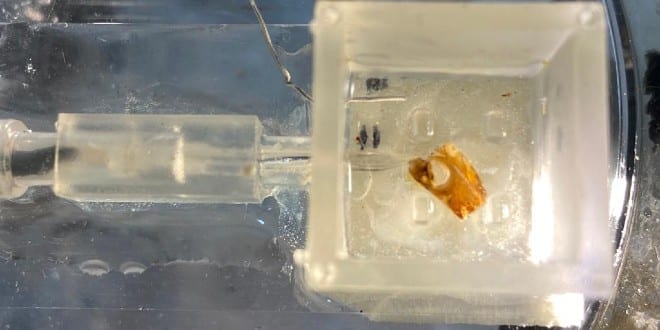Biological systems usually have a huge advantage over technological systems both in terms of sensitivity and in terms of energy consumption. So if scientists can merge the senses of robots and insects, such an innovation could make much-more-unwieldy and -expensive developments in the field of robotics unnecessary.
A technological and biological development that is unprecedented in Israel and the world has been attained at Tel Aviv University (TAU) For the first time, the ear of a dead locust has been connected to a robot that receives the ear’s electrical signals and responds accordingly. The result is amazing: When the researchers clap once, the locust’s ear hears the sound and the robot moves forward; when the researchers clap twice, the robot moves backwards.
The interdisciplinary study was led by Idan Fishel, a joint master student under the joint supervision of Dr. Ben Maoz of TAU’s Fleischman Faculty of Engineering and the Sagol School of Neuroscience, Prof. Yossi Yovel and Prof. Amir Ayali at the School of Zoology and the Sagol School of Neuroscience; and Dr. Anton Sheinin. Yoni Amit and Neta Shavil. The results of the study were published in the prestigious journal under the title: Ear-Bot: Locust Ear-on-a-Chip Bio-Hybrid Platform.”
During hundreds of millions of years of evolution, insects have evolved some of the most efficient and robust sensing organs, often far more sensitive than their man-made equivalents, the team wrote in their article. “In this study, we demonstrate a hybrid bio-technological approach, integrating a locust tympanic ear with a robotic platform. Using an Ear-on-a-Chip method, we manage to create a long-lasting miniature sensory device that operates as part of a bio-hybrid robot.
The shortcode is missing a valid Donation Form ID attribute.
The researchers explain that at the beginning of their study, they sought to learn how the advantages of biological systems could be integrated into technological systems and how the senses of a dead locust could be used as sensors for a robot. “We chose the sense of hearing, because it can be easily compared to existing technologies, in contrast to the sense of smell, for example, where the challenge is much greater,” noted Maoz. “Our task was to replace the robot’s electronic microphone with a dead insect’s ear, use the ear’s ability to detect the electrical signals from the environment, in this case vibrations in the air, and, using a special chip, convert the insect input to that of the robot.”
To carry out this unique and unconventional task, the interdisciplinary team of Maoz, Yovel and Ayali faced a number of challenges. In the first stage, they built a robot able to respond to signals it receives from the environment. Then, in a multidisciplinary collaboration, the researchers were able to isolate and characterize the dead locust ear and keep it alive and functional – long enough successfully to connect it to the robot. In the final stage, the researchers managed to find a way to pick up the signals received by the locust’s ear in a way that could be used by the robot. At the end of the process, the robot was able to “hear” the sounds and respond accordingly.
Overall, they performed 29 experiments on each of the locust tympanal (hearing) organs, each employing between 12 and 36 stimulus repetitions, to finally obtain 1,836 recordings of the auditory nerve spike response pattern.
“Prof. Ayali’s laboratory has extensive experience working with locusts, and they have developed the skills to isolate and characterize the ear,” commented Maoz. “His laboratory built the robot and developed code that enables the robot to respond to electrical auditory signals, and my lab has developed a special device – an Ear-on-a-Chip – that allows the ear to be kept alive throughout the experiment by supplying oxygen and food to the organ, while allowing the electrical signals to be taken out of the locust’s ear and amplified and transmitted to the robot.
It should be understood that biological systems expend negligible energy compared to electronic systems, said Maoz. “They are miniature and therefore extremely economical and efficient. For the sake of comparison, a laptop consumes about 100 watts per hour, while the human brain consumes about 20 watts a day. Nature is much more advanced than we are, so we should use it. The principle we have demonstrated can be used and applied to other senses, such as smell, sight and touch.”
The integrated Ear-Bot platform demonstrates that a biological hearing system can serve as an auditory sensory input to direct a robot, said Maoz. “This platform presents a new ability of bio-hybrid robots that opens the way for the use of a variety of biological auditory systems, which are extremely diverse in their capabilities as input for bio-hybrid robotic systems.”
For example, he suggested, “some animals have amazing abilities to detect explosives or drugs; the creation of a robot with a biological nose could help us preserve human life and identify criminals in a way that is not possible today. Some animals know how to detect diseases. Others can sense earthquakes. The sky is the limit.”
The shortcode is missing a valid Donation Form ID attribute.



